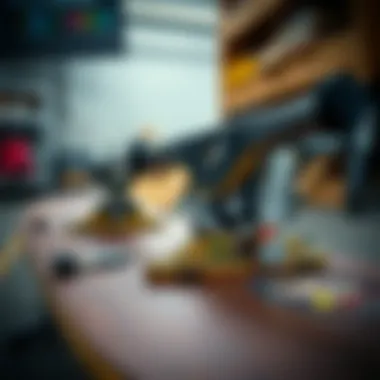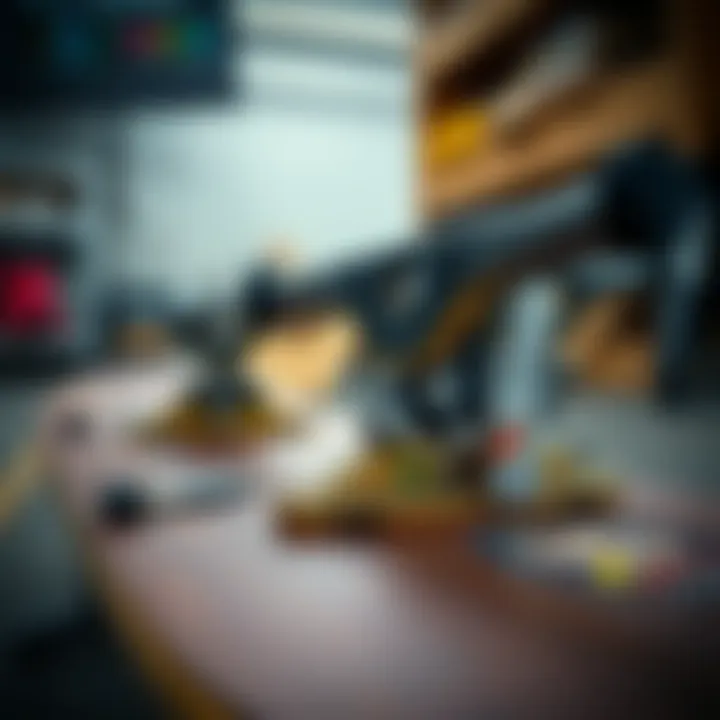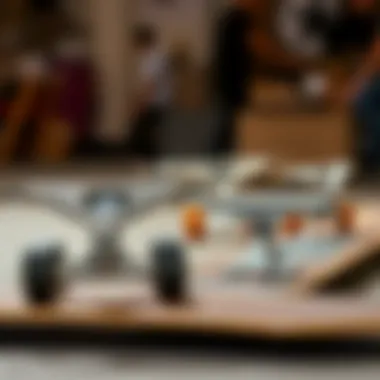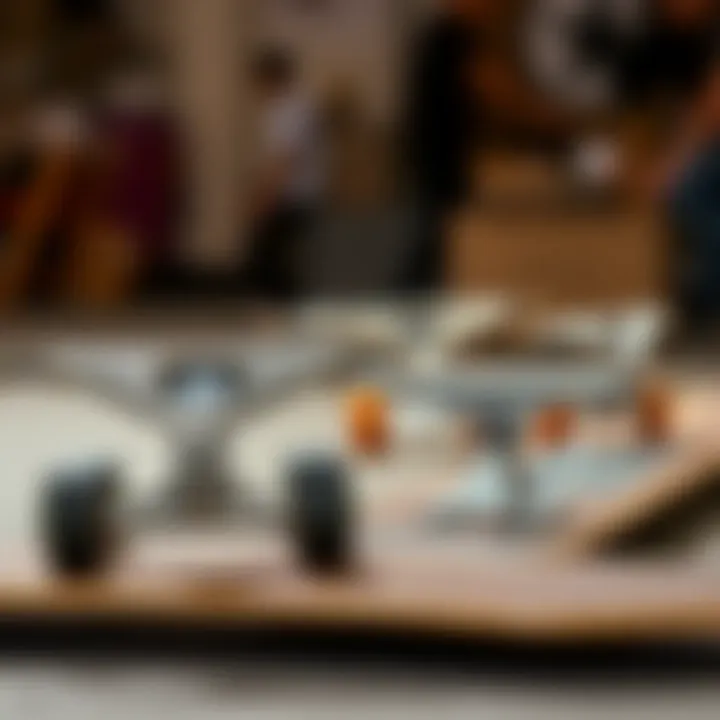Understanding 5.5 Skateboard Trucks: A Guide


Intro
Skateboarding is more than just a sport; it’s a lifestyle, a form of expression, and, for some, a career. At the core of this exhilarating activity lies an often overlooked component: the skateboard trucks. Particularly, the 5.5 trucks are a point of interest for many skaters. Understanding the nuances of these trucks can significantly enhance your ride and inform your choices when it comes to gear.
In this guide, we will break down key aspects of 5.5 skateboard trucks—how they are constructed, their design variations, and their role within the skateboarding community. You will discover the impact of size and geometry, the implications of material choices, and current trends that resonate with both amateurs and seasoned pros. We will also touch on maintenance tips and adjustment techniques, which are crucial for keeping your set up in tip-top shape.
By getting a handle on these elements, you’ll be set to choose the right 5.5 skateboard trucks that align with your unique riding style.
Essential Skateboarding Gear
Having the right gear can make or break your skateboarding experience. Understanding what trucks, especially the 5.5 variants, are suitable for you is important as they affect turn radius, stability, and overall performance.
Top Picks for Skateboards and Accessories
When considering 5.5 skateboard trucks, a few brands shine brightly in the eyes of skaters:
- Independent Trucks: Known for their durability and performance. A trusted name among professionals.
- Tensor: Often preferred for lightweight performance without sacrificing strength.
- Thunder: Popular for their balance between responsiveness and stability.
Remember, the right skateboard deck also complements these trucks. Look for decks with a width that suits your riding style. Generally, a width of 7.75 to 8.25 inches works well with 5.5 trucks.
Maintenance Tips for Longevity
Maintaining your trucks is vital for performance. Here are some simple tips:
- Regular Checkups: Inspect your trucks for wear and tear often. Look for cracks or bending, especially after heavy use.
- Lubrication: Use appropriate lubricant on the pivot cups to ensure smooth turning. A little goes a long way.
- Tightening Hardware: Regularly check the nuts and bolts on your trucks. Ensure they're tight but not overtightened to avoid breakage.
Proper maintenance not only extends the life of your gear but also enhances your overall skating experience.
Skateboarding Tricks and Tutorials
Truck selection can greatly influence the tricks you aim to perform. Each skater brings their own style to the game, and having the right trucks is key.
Beginner Tricks to Get You Started
If you're new to skateboarding, start with:
- Ollie: The foundational trick for most others. Practice it on flat surfaces.
- Kickflip: Once you master the ollie, this trick takes your style up a notch.
- Grind: Utilizing your trucks, the grind introduces you to balance and control on ledges.
Advanced Techniques for Seasoned Skaters
As you progress, consider exploring:
- 180 and 360 Shuvits: These tricks rely heavily on your truck's responsiveness.
- Smith and Feeble Grinds: Understanding the nuances of your truck's dynamics will enhance your grind techniques.
- Blunt Slides: These add flair and are a crowd-pleaser when done right.
Taking the time to understand how 5.5 skateboard trucks perform under various styles can elevate your skills tremendously.
Prelims to Skateboard Trucks
Skateboard trucks might seem like mere metal pieces holding the wheels, but their significance runs deeper. The right truck can enhance maneuverability, stability, and overall performance of a skateboard. For skaters of all levels, understanding trucks is crucial.
When you step on your board and glide down the pavement, it is the trucks that give you the necessary balance, allowing you to carve, ollie, or navigate through urban landscapes. The quality, size, and design of these components determine how well you can execute tricks and negotiate obstacles. Choosing the right pair of trucks may seem overwhelming at first, but once you grasp the basics, it becomes an easier road to navigate.
Definition and Function
To put it plainly, skateboard trucks are the metal structures that connect the wheels to the deck of a skateboard. They consist of several parts including the hanger, baseplate, and kingpin, all working in unison to provide functionality. In other words, trucks are the backbone of the skateboard.
- Hanger: This is the part that holds the wheels and rotates when you lean.
- Baseplate: The piece fixed to the board, providing attachment and stability.
- Kingpin: A bolt used to hold the other components together, crucial for turning.
Understanding these components allows skaters to optimize their rides. Each part plays a unique role, from how sharp you can turn to how smooth your ride may feel on rough terrain.
Role in Skateboard Performance
The influence of skateboard trucks on performance cannot be overstated. Essentially, they alter the feel of your board. Are you more of a street skater who enjoys technical tricks, or do you thrive in parks executing smooth transitions? Your riding style greatly impacts your choice of trucks.
- Stability: A broader truck base increases stability, ideal for those practicing big tricks or riding fast.
- Agility: Narrower trucks allow quicker turns, suitable for skaters who prefer technical moves.
- Durability: The materials used in truck construction affect how they perform under pressure; therefore, selecting the right materials can enhance long-term resilience.
Ultimately, investing time in understanding these aspects can significantly elevate a skater’s experience, leading to better control and confidence on the board.
Properly tuned trucks can make a world of difference in your skating capabilities, often setting apart the novice from the seasoned rider.
The Significance of Size: Exploring 5. Trucks
Size plays a pivotal role when it comes to skateboard trucks, particularly the 5.5 variants. Understanding the significance of size helps riders make informed decisions that enhance their performance and comfort on the board. 5.5 trucks bridge the gap between agility and stability, tailored for a variety of skating styles.
One should consider that the width of skateboard trucks directly affects how a skateboard handles. A wider truck like the 5.5 offers better stability for tricks that require balance, while still allowing for responsive turns. Skaters who often grind or perform wide swings may find the 5.5 size to be particularly advantageous. This size also caters to those who require a good compromise between flick for tricking and the stability needed for downhill rides.
Why Choose 5.
When deciding on the right truck size, the 5.5 option shines for several reasons. This particular size is versatile enough for both street and park riding. For those who like to mix and match styles, 5.5 trucks can be a golden choice.
Another reason to choose 5.5 trucks lies in their increased leveragability. Skaters engaging in technical tricks will appreciate how these trucks facilitate cleaner execution. Also, they accommodate a variety of deck widths without feeling out of place.


Given their popularity, many reputable brands manufacture 5.5 trucks. This leads to a rich array of options in terms of materials and designs. Significantly, your choice of 5.5 can enhance not just the board but your overall skateboarding experience.
Comparison with Other Sizes
4. Trucks
A conversation on truck sizes would be incomplete without comparing the 4.5 trucks. These more petite trucks typically cater to skaters looking for a lightweight setup.
- Key Characteristic: The more nimble nature of these trucks makes them an attractive option for tricks that require high levels of agility.
- Advantages/Disadvantages: While their size may excel in maneuverability, it often loses out in stability, particularly during high-speed rides or landings. Thus, they are most often favored by street skaters focusing on technical moves and ledge work.
5. Trucks
Jumping to the 5.0 variants, the middle ground between the 4.5 and 5.5 has its own set of attributes.
- Key Characteristic: The 5.0 trucks provide a fine balance of stability and agility, making them a sound choice for all-around skating.
- Advantages/Disadvantages: They do offer versatility but might not always be as responsive for technical tricks compared to 4.5 models.
6. Trucks
On the other end of the spectrum, the 6.0 trucks excel in stability and durability for larger riders or those engaging in more aggressive styles.
- Key Characteristic: These are suited for larger decks, which translates to a more stable feel during fast rides or rough terrains.
- Advantages/Disadvantages: However, their bulk can be a hindrance in tight spaces or making quick turns. Therefore, they may not be the first choice for skaters focusing on tricks or street skating.
Ultimately, the selection process hinges on not just size but the individual skater's style and preferences. Choosing 5.5 trucks can provide a robust sense of security while skirting the line between precision and versatility.
Key Features of 5. Skateboard Trucks
Understanding the key features of 5.5 skateboard trucks is essential for any skater looking to maximize performance and ride quality. The right combination of materials, design elements, and geometry enhances not just how a skateboard feels underfoot, but also how it responds during different tricks and maneuvers. From the way trucks are constructed to their interaction with riding styles, a thorough examination here reveals all the components that make these trucks distinctive.
Materials Utilized
Aluminum
Aluminum is the most common material used for skateboard trucks. It's appreciated for being lightweight yet durable, providing the ideal balance for skaters. One key characteristic of aluminum is its high strength-to-weight ratio. This means that even with its low weight, aluminum can handle the pressures of street or ramp interaction without warping or bending. A unique feature of aluminum is that it can be easily manufactured into precision components, allowing for optimized designs specific to skating needs. However, while aluminum has many advantages, it can sometimes be less resistant to corrosion compared to other materials, which can be a consideration for those skating near saltwater or in wet conditions.
Steel
Steel, on the other hand, brings a different set of advantages to skateboard trucks. Its primary characteristic is its incredible toughness and resistance to damage. Steel trucks can withstand greater impacts, making them a popular choice for skaters who prioritize durability over weight. The unique feature of steel is its innate ability to absorb shock, providing riders with confidence during landings, especially on heavy tricks or in park setups. However, the downside of using steel is its weight, which can lead to a less agile riding experience compared to aluminum. This heavier nature may not be ideal for technical street skaters who require a flicker of lightness.
Composite Materials
Composite materials, made by combining different substances, present an interesting alternative in skateboard truck construction. They may offer lighter weights while maintaining considerable strength. A significant characteristic of composite materials is their ability to absorb vibrations better than metals, which can result in a smoother ride. This quality is beneficial for street riders who experience varied surfaces. On the flip side, some composites may not hold up as well under high-stress situations as metals do. The variations in material quality can be perplexing for skaters, making careful selection paramount.
Design Elements and Geometry
Hangar Shape
The shape of the hangar is a crucial element that impacts how a truck performs. A well-designed hangar will offer stability when skating, allowing for smooth turns and quick responses. The unique feature of common hangar shapes is that they can influence the turning radius and feel of the board underfoot. Slightly wider hangars might lend better support for landing tricks, while narrower ones enable sharper turns. The complexity of the hangar design can cater to varying riding styles, but skaters must consider the potential trade-offs in terms of stability and maneuverability.
Baseplate Design
The baseplate design is equally significant as it influences how the truck mounts onto the skateboard deck. This element will determine how high the truck sits above the board. A well-designed baseplate will lead to improved stability while skating at higher speeds or performing tricks. The unique characteristic of different baseplate designs is that they can have direct impacts on the truck's angle and, thereby, the ride height. For instance, a 5.5 truck with a higher baseplate might offer enhanced pop for ollies but can also raise the center of gravity, making balance trickier for some riders. Understanding the nuances of baseplate design empowers skaters to customize their ride according to their performance goals.
Key takeaway: Familiarizing oneself with the materials and design elements of 5.5 skateboard trucks helps in making informed choices, catering to individual skating preferences and enhancing overall performance.
Adjustment and Maintenance of Skateboard Trucks
Keeping your skateboard trucks in check is a key part of ensuring a smooth and enjoyable ride. Whether you're new to skateboarding or a seasoned pro, the adjustment and maintenance of your 5.5 trucks cannot be skipped. This section conveys the importance of precision adjustments and regular maintenance practices to keep your trucks functioning at their best. Regular maintenance saves you from unexpected mishaps and enhances your overall skating experience.
Initial Setup: Importance of Precision
When you first install your 5.5 trucks, getting the setup just right is critical. It’s not simply about slapping them on your deck and calling it a day. Every skater has their personal preferences regarding truck height, width, and tightness, and achieving the right mix can significantly impact your performance.
Precision here means ensuring that the trucks are aligned correctly with the wheels, providing the right amount of clearance. This alignment affects not just how you turn, but how comfortable you feel performing tricks, too. Loose trucks might lead to slip-ups mid-air, while trucks set too tight can stunt your ability to carve smoothly.
In the end, remember the old adage: "Measure twice, cut once." It applies nicely in this context. Be patient during the initial setup and take the time you need. The result? A more confident ride that is truly responsive to your movements.
Routine Maintenance Practices
Regular maintenance helps maintain longevity and functionality of your 5.5 skateboard trucks. It's not a daunting task, but rather a series of simple checks that can turn into a habit, keeping your ride sharp and ready.
Lubrication Tips
One vital aspect of maintenance is lubrication. Over time, bearing and pivot points can dry out, resulting in stiff maneuverability or noise during tricks. Using a lightweight, skate-specific lubricant helps to keep everything running smoothly. It’s important to avoid using heavy oils, as they might attract more dirt and grime, leading to more problems down the line.
- Key Characteristic: Lightweight lubricants penetrate easily, ensuring that they reach all vital areas without causing gunk build-up.
- Unique Feature: Many lubrication products designed for skateboard trucks come with applicators that allow for precise distribution, targeting the exact places that need attention.
Overall, regular lubrication extends the life of your trucks as well as enhances your riding experience through smoother transitions. No one wants their ride to feel like it’s dragging through molasses.
Components Check
Keeping an eye on the various components of your trucks is another crucial maintenance practice. Regular checks can help you identify any wear or damage before it becomes critical. Inspecting the bolts, bushings, and kingpins should be part of your routine. Each element contributes to how your board behaves and feels while riding. If any part shows signs of excessive wear or loosening, it’s advisable to replace them sooner rather than later.


- Key Characteristic: Regular component checks keep your board on the level by preventing minor issues from compounding into major problems.
- Unique Feature: With the availability of aftermarket components, replacing worn-out parts can also lead to improvements in performance, allowing you to customize your setup further.
Ultimately, a little TLC on your trucks goes a long way. With consistent attention to both lubrication and component checks, you can significantly elongate the life of your 5.5 skateboard trucks and keep your riding experience at its peak.
The Influence of Riding Style on Truck Selection
The choice of skateboard trucks is not a one-size-fits-all affair; it greatly depends on an individual’s riding style. The trucks fundamentally determine how a skateboard handles, turns, and responds to different maneuvers. Understanding this influence can transform a rider’s overall performance, whether they are cruising down the street, hitting ramps in a park, or executing technical tricks. By tailoring truck selection to specific skating styles, skateboarders can enhance stability, control, and facilitate better trick execution.
Street vs. Park Skating
Riders who primarily skate in the streets have distinct needs compared to those who prefer park skating. Street skaters typically prioritize low-profile trucks that allow for better control during technical tricks. The agility offered by a tighter turn radius is essential when navigating obstacles like benches or rails. In contrast, park skaters often opt for a slightly wider truck for increased stability during aerial tricks and transitions in bowls.
Street skaters might also lean towards lighter trucks to retain mobility for flip tricks and grinds, while park skaters appreciate the added weight for momentum in their tricks.
It's vital to recognize these differences when choosing 5.5 skateboard trucks since each style's needs can dramatically shape the experience on the board.
Impact of Trick Types
Grinds
Grinds require specific truck features to execute well. The key characteristic of a grind is the several ways skaters can slide along ledges or rails. For these maneuvers, the truck's durability becomes crucial, as grinds can wear out components quickly. A beneficial aspect of 5.5 trucks is their robust construction, often using tough materials that withstand harsh grind sessions. Unique to grinds is their variable balance; in executing grinds, a rider must maintain stability while shifting their weight, making the precise design of the trucks critical. It's a dance between weight distribution and the grind surface.
Advantages: 5.5 trucks typically have solid bushings and a stable base, which makes them a preferred choice for this trick type, providing riders with a responsive feel and solid control.
Disadvantages: However, if too heavy, they can hinder a skater's ability to lift the board quickly, which may impact their grind attempts.
Flips
Flips are another important trick type, focusing heavily on the rider's ability to easily rotate the board beneath them. The pivotal factor in flips is the tail of the skateboard; hence, skaters often choose lighter trucks to facilitate a snappy response when popping the board. The unique feature here is the responsiveness of the truck, which plays a pivotal role in generating the lift needed for successful flips.
Advantages: 5.5 trucks also offer a balanced setup ideal for quick flips, enabling skaters to achieve higher rotations with ease.
Disadvantages: On the flip side, if a truck is too soft, it can compromise stability during the flip, making it harder to land the trick cleanly.
Slides
Slides contribute another dimension; they focus more on gliding and smooth transitions along surfaces. The characteristic that defines slides is the necessary control throughout the slide itself. A skater has to modulate their weight effectively and engage the right combination of friction with the board's wheels and the sliding surface. This is where 5.5 trucks shine, as they often maintain a compatibility with a wider range of wheels that aid in linking movement and speed.
Advantages: With their construction, 5.5 trucks help skaters maintain control during a slide, enhancing predictability and performance during the trick.
Disadvantages: However, if the angle is off or if the bushings don’t support needed flexibility, functionality can be compromised, and skaters might find themselves struggling to maintain balance while sliding.
Understanding how different styles of tricks influence truck selection can empower riders to optimize their skills, ensuring that every grind, flip, or slide adheres to their individual riding style.
Current Trends in Skateboard Truck Design
Current trends in skateboard truck design reveal a fascinating evolution in both functionality and style. With skateboarding's rising prominence and continued diversifiction, not only are manufacturers pushing the envelope with innovative technologies, but skaters are also becoming more discerning about their equipment. This section looks into key aspects relevant to today's skaters, manufacturers, and design enthusiasts.
Innovations in Manufacturing
As skateboarding embraces technological advancements, truck manufacturing has witnessed notable innovations. One of the most significant developments is the adoption of lightweight materials that maintain structural integrity. Companies such as Independent and Tensor are producing trucks with advanced aluminum alloys, reducing weight without compromising strength.
“Lightweight trucks make for better pop and flick, giving tricks that extra snap.”
Apart from materials, precision engineering plays a crucial role in manufacturing 5.5 skateboard trucks. Techniques such as CNC machining deliver exceptional accuracy in truck geometry, which directly contributes to stability and maneuverability on the board. Notably, some brands are experimenting with varying manufacturing methods, from forging to casting, each bringing their own set of benefits to performance.
Moreover, the use of computer-aided design (CAD) in the initial stages of development is shaping product outcomes. By simulating different designs and performance scenarios, manufacturers can optimize their products before physical prototypes are even built. This proactive approach not only enhances efficiency but also aligns product specs closely with the preferences of skaters.
Popular Brand Offerings
In today's dynamic skateboarding landscape, various brands stand at the forefront, introducing cutting-edge truck designs. Among these, Baker, Element, and Silver are noteworthy mentions. Each brand caters to specific skater preferences and styles, enhancing the overall skateboarding experience.
- Baker: Known for their robust yet lightweight trucks, they have built a reputation for reliability in both street and park settings. These trucks appeal to a wide spectrum of skaters, from novices to seasoned pros.
- Element: Their emphasis on sustainability has led to eco-friendly truck designs, leveraging materials that are not only durable but also contribute to a lower environmental impact. Element’s trendy designs have made their trucks particularly popular among young skaters.
- Silver: With a focus on affordability without skimping on quality, Silver trucks are accessible to a broad range of skateboarders, especially those just starting. They offer great value, making them a go-to choice for newcomers.
The future looks promising as new players continue to emerge, and established brands innovate further. By keeping an eye on trends and how consumer preferences evolve, skaters can make informed decisions that elevate their rides.
As we explore the subsequent sections, we'll delve deeper into customization options and setups that meet the demands of skaters looking for both performance and personalization in their gear.
Customization Options for 5. Trucks
Customization in skateboard trucks is not just a trend; it’s a way for riders to express their individual style while enhancing their overall ride. For those riding 5.5 trucks, the options are varied and can greatly influence performance and aesthetics. Understanding these customization avenues can lead to a more personalized and enjoyable skating experience.
Painting and Aesthetic Enhancements
A fresh coat of paint can breathe new life into your skateboard setup. For many riders, customizing the look of their 5.5 trucks is as important as their performance.
- Choice of Colors: Bright colors can stand out at the skate park, while more subdued hues may appeal to those favoring a classic look. Customizing colors can reflect the rider’s personality or even match the deck's graphic.
- Techniques: Techniques like spray painting, airbrushing, or using stickers can all turn basic truck designs into eye-catching pieces of art.
- Durability Considerations: Using high-quality paints and sealants ensures the aesthetic enhancements withstand the regular wear and tear of skating.
Taking the time to beautify your trucks with personal touches can indeed make a difference. Besides appealing to the eye, it can also lead to conversations with fellow skaters, creating a sense of community.
Aftermarket Components
Upgrading certain components of your 5.5 trucks can remarkably influence how they perform. Here’s a closer look at the key aftermarket components that riders consider when customizing:
Bushings
Bushings play a crucial role in how your skateboard trucks articulate and respond to your movements. Choosing the right bushings can make or break your ride.


- Specific Aspect: The durometer or hardness of the bushings greatly affects how responsive your turns are. Softer bushings provide more flex, making them excellent for beginners or those who prefer tighter turns. Conversely, harder bushings help experienced skaters maintain stability at high speeds.
- Key Characteristic: The rebound of bushings contributes to how quickly your truck returns to a neutral position after a turn.
- Unique Feature: Some bushings come in different shapes or materials like urethane—this can improve their durability and responsiveness.
Collectively, choosing the right bushings results in a smoother, more controlled ride.
Kingpins
The kingpin is vital for the structure and functionality of a truck. An effective kingpin can offer enhanced performance and stability.
- Specific Aspect: While most trucks come with standard kingpins, some aftermarket options are designed to be stronger and lighter. This can reduce the overall weight of the skateboard while maintaining its integrity.
- Key Characteristic: The height of a kingpin might influence how high you can ride on your skateboard, which is crucial for tricks.
- Unique Feature: Adjustable kingpins allow a rider to tweak their truck's angle. This customization helps skaters find their perfect setup.
Maintaining or upgrading your kingpin ensures consistent performance, particularly if you're pushing your limits.
Wheels
Selecting the right wheels can drastically change not just the ride feel but also the entire skateboarding experience.
- Specific Aspect: Wheel hardness and diameter play vital roles in how a skateboard handles. Softer wheels provide greater grip and are better suited for street skating, while harder wheels slide easier and are favored for tricks and skateparks.
- Key Characteristic: Larger wheels can absorb shock better, offering a smoother ride on various terrains.
- Unique Feature: Some wheels come with unique surface patterns, designed to enhance grip or slide capabilities depending on the rider’s preference.
The right wheels complete the customization, ensuring that every push, trick, or slide feels just right.
Advanced Techniques for Experienced Riders
Skateboarding is not just about balance and tricks; it's about understanding the nuances of your setup. For experienced riders, refining what they already know can elevate their performance to new heights. This section delves into two advanced techniques that can make a significant difference in how 5.5 skateboard trucks affect your ride.
Fine-Tuning Truck Height and Stability
The height of your skateboard trucks plays a crucial role in how it performs. Finding the right height can lead to a more comfortable ride and improved control during tricks. When you adjust the truck height, several factors come into play:
- Board Flip Dynamics: A lower truck can facilitate quicker flip tricks, making them easier to execute. If you like to pop ollies high, consider keeping your trucks on the lower side.
- Stability: Higher trucks often provide more stability during wide turns or when landing heavy tricks. However, they might complicate flip tricks.
- Preferred Skate Style: Street skaters may benefit from lower setups, while ramp riders often prefer higher trucks for better stability and power.
Experimenting with washers beneath the kingpin can change the height without swapping out the trucks entirely. Just add one or two washers to find that sweet spot where the board feels effortless beneath your feet.
"Adjustments may be subtle, but they can lead to monumental changes in performance."
Experimenting with Different Angles
Changing the angle of your trucks, known as the baseplate angle, can have profound effects on your skating experience. Here’s why adjusting angles is vital:
- Turning Radius: A steeper angle increases maneuverability, enabling sharper turns. This comes in handy for slalom courses or tight street lines.
- Responsive Feel: Lower angles give a more stable ride, ideal for technical tricks where confidence in stability is key.
- Personal Preference: Ultimately, the correct angle often comes down to the individual skater. Some prefer a responsive feel for technical tricks, while others gravitate towards stability for smoother rides.
How to measure the angle? Most trucks have pre-set angles ranging from 40 to 50 degrees. You can also invest in an angle finder to ensure precise adjustments. It’s all about tuning your ride to fit your personal style.
Both truck height and angle adjustments bring new dimensions to skateboarding, transforming routines into unique performances tailored to one's preferences. Fine-tuning is not just a technical process, but a deeply personal one that connects skater and board, passion and precision.
Troubleshooting Common Truck Issues
Troubleshooting common truck issues is essential for any skateboarder, whether you ride on a local street or perform tricks in a park. A smooth skating experience hinges not just on skill and technique, but also on the condition of your gear. Skateboard trucks play a pivotal role in the overall performance, and understanding potential problems can save both time and money. Paying attention to these aspects ensures you maintain full control of your board and enhances your riding experience.
Identifying Wear and Tear
Recognizing wear and tear on your skateboard trucks is the first step toward effective troubleshooting. Just like an engine needs maintenance, so do trucks. Look for visual indicators of distress, such as:
- Cracks or Dents: Examine the hanger and baseplate closely for cracks. Dents may not be visible at first glance but checking for unusual bumps could save your skateboard from catastrophic failure.
- Rust or Corrosion: Steel parts can rust if exposed to moisture. If you notice rust forming, it’s a sign that you may need to replace components sooner than later.
- Reduced Performance: A truck that acts sluggish during turns or feels unstable is likely suffering from wear. Pay attention to how your skateboard behaves during tricks; changes can often indicate deeper issues.
By routinely inspecting your trucks, you can catch problems before they require extensive fixes or replacement.
Responding to Trucks That Feel Loose
If your trucks feel loose, it might be cause for concern but it also might be a simple fix. First, check if your kingpin nut is tightened sufficiently. Here’s what to do:
- Tighten Kingpins: Use a skate tool or wrench to make sure the kingpin nuts are snug. If they’re too loose, it can lead to instability while riding.
- Inspect Bushings: Worn-out bushings can also contribute to a loose feel. If your trucks feel soft, you might need to replace bushings that have seen better days.
- Test the Tightness: After adjustments, test ride your skateboard to see if it still feels loose. If it does, assess the setup once more.
Fixing loose trucks is vital for safety. An unstable board can lead to falls, so don’t ignore this issue.
"Low-quality parts or poor maintenance will wear out your equipment faster, so always put quality first."
In summary, understanding how to troubleshoot common truck issues impacts your ride significantly. From identifying wear and tear to addressing loose trucks, staying proactive will keep your skateboard in peak shape. Regular check-ups not only improves performance but also makes for a safer skating experience.
For more information about skateboard maintenance and gear, check out resources like Skateboarding.com or Reddit's skate community.
Through consistent care and diligence, you can ensure that your 5.5 trucks will serve you well for years to come.
The End: The Future of 5. Skateboard Trucks
The landscape of skateboarding continues to evolve, and with it, the relevance of 5.5 skateboard trucks becomes even more significant. As technology advances, skaters are looking for specific attributes in their gear that align with their performance aspirations and personal style. Understanding where these trucks stand now and how they may shift in the future is essential for both seasoned riders and newcomers alike.
Emerging Technologies
The skateboard industry is witnessing remarkable innovations. Materials that were once considered standard are being replaced or enhanced with lighter, stronger alternatives. For instance, early models were primarily made from aluminum or steel. Now, composite materials are emerging that offer greater durability while minimizing weight.
Moreover, manufacturers are experimenting with robotics in the manufacturing process, allowing for precision production that results in greater consistency. Think about trucks that can be fine-tuned to an individual rider's preference at the time of assembly. Such advancements could reshape how skaters view customization and performance.
It’s clear that the integration of new technologies into skateboard design is not merely an option; it's fast becoming a necessity. In an age where personal expression holds significant weight, the ability to customize and optimize performance can set a skater apart.
Predicted Trends in Skateboarding Preferences
As we look toward the future, certain trends are likely to influence skateboard truck preferences:
- Customization Acceleration Much like fashion, skateboard aesthetics are constantly changing. Skaters increasingly want trucks that reflect their unique style, coupled with high functionality to match their riding style. Bright colors, artistic patterns, or even glow-in-the-dark finishes might dominate the scene.
- Eco-conscious Materials The skateboarding community has become more aware of environmental issues. Expect trucks made from recycled materials or sustainably sourced composites, appealing to eco-friendly riders. Skaters want to enjoy their sport without leaving a heavy footprint.
- Rise of Tech Integration Imagine trucks embedded with sensors that provide feedback on performance metrics. This data can guide skaters in improving their skills or making adjustments in real-time.



